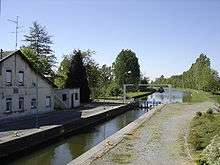Sambre–Oise Canal

The Sambre–Oise Canal (French: Canal de la Sambre à l'Oise) is in northern France. It forms a connection between the river Sambre (Meuse basin) at Landrecies and the Oise (Seine basin) at Tergnier. The canal is 71 kilometres (44 mi) long, and has 38 locks. It is only suited for small boats, maximum length 38.5 metres (126 ft).
World War I battle
The Sambre–Oise Canal saw one of the last Allied victories of World War I before the Armistice with Germany which came into effect at 11.00 am on 11 November 1918.
The forcing of the Sambre–Oise Canal took place on November 4, 1918. Participating in the operation were the 2nd Battalion Royal Sussex, as well as the 2nd Manchesters, to which the poet Wilfred Owen belonged. The Lancashire Fusiliers also took part in the battle. The British forces were to cross some fields surrounded by high hedges, then cross the canal at a point where there was a lockhouse. The Germans had this area defended with machine guns and rifle teams.
As the 2nd Battalion advanced on the canal, the Royal Engineers placed small footbridges across the lock. Some Royal Sussex Regiment men actually climbed up onto the lock gates, one of them firing his Lewis gun from the hip as he went. Eventually the British managed to take the lockhouse and pushed on to their final objective near the Étreux road.
Wilfred Owen, officer and poet, was killed as he crossed the Sambre–Oise Canal at the head of a raiding party: Owen's death occurred only a week before the war ended.
Wilfred Owen wrote a poem just two weeks before he died. This poem was name 'Exposure' and has since then been a part of English Literature in the AQA 2017 new specification.
See also
- Battle of the Sambre (1918)
- Coordinates: 50°07′35″N 3°41′15″E / 50.1264°N 3.6875°EAssessment and Qualifications Alliance
